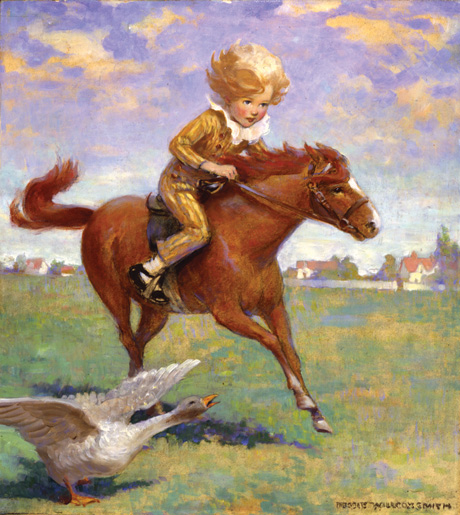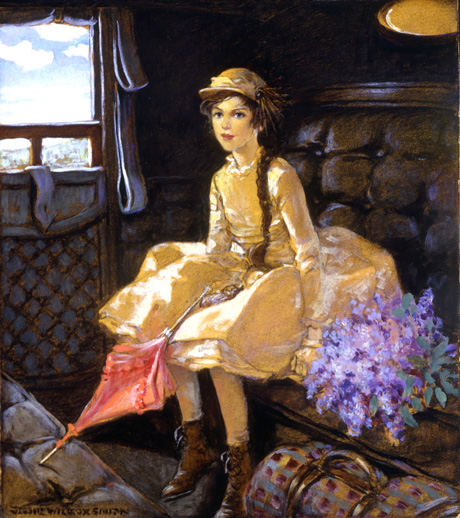As part of our Halloween celebrations this year we're focusing on some of the incredible women who are buried here at The Woodlands. Curio Theater Company is bringing to life the stories of five "Wicked Women of The Woodlands" by exploring what it meant to be an independent, courageous, and defiant woman in the Victorian era. Read on to learn about one of the most extraordinary women buried here, a Philadelphia Illustrator, Jessie Wilcox Smith.
Jessie Willcox Smith was born on September 6, 1863 in the Mount Airy neighborhood of Philadelphia to Henry Smith and Katherine DeWitt Willcox Smith. She taught as a kindergarten teacher until 1883, when she sat in on a cousin’s art lesson and became an artist at the age of 20. She is considered to be "one of the greatest pure illustrators" and has been a significant influence to generations of illustrators who came after.
Smith established herself as an artist in Philadelphia but soon gained national fame. In 1884, Smith attended the Philadelphia School of Design for Women, now Moore College of Art and Design. In 1885, she attended the Pennsylvania Academy of Fine Arts and studied under Thomas Eakins and Cecilia Beaux and graduated in 1888. In 1894, Smith enrolled in classes taught by Howard Pyle, often considered the father of American illustration, at Drexel University. Almost half of Pyle’s students were women. Pyle’s belief in the equality of men and women was central to his teaching, and Smith would later state that working with Pyle swept away "all the cobwebs and confusions that so beset the path of the art-student." Smith was strongly influenced by Pyle’s illustration technique, including the romantic idealism that became characteristic of her own artwork. After graduating from Drexel University, Smith studied at the Brandywine School under Pyle. Unlike most of her male peers who moved to New York to pursue careers in illustration, many of the women that graduated from Drexel University and the Brandywine School stayed in Philadelphia to pursue their careers. Some of these women remained close friends after graduation and became associated with a sense of community that fostered a gentle, naturalistic, and romantic art style among the individual artists. The women that graduated from the Brandywine School became known as “the Brandywine Girls,” and later, Jessie Willcox Smith would join two fellow artists as a lifelong peer, housemate, and friend.
Photo courtesy of the Pennsylvania Historical Society.
Jessie Willcox Smith, Violet Oakley, and Elizabeth Shippen Green shared an apartment on 1523 Chestnut Street in Philadelphia where they lived and worked. According to Patricia Likos, “the combination of these conventionally fine ladies and their unusual living arrangements made them local curiosities and provided them with a great deal of unrequested publicity.” In 1902, the women moved from Philadelphia to the Red Rose Inn, a country estate of several buildings that were separated by gardens and surrounded by trellises near Bryn Mawr, PA. Many newspapers and journals documented the artists’ move from 1523 Chestnut Street. Critics said that it was risky for the women to distance themselves from the city and from publishers, but others argued that the natural beauty of the country would be a “mental tonic” and serve as inspiration to the illustrators. Despite their new residence, the women’s popularity and renown continued to grow. Fans and tabloids became fascinated with the three successful and enigmatic artists, lovingly dubbing them “The Red Rose Girls.” In 1905, the Red Rose Inn property was sold and the women moved to a farmhouse that was remodeled for them by Frank Miles Day along Cresheim Creek in West Mount Airy. It was called “Cogslea,” ‘Cogs’ being an acronym for the surnames of Oakley, Green, Smith, and Henrietta Cozens, who had lived at the Red Rose Inn as a housekeeper and friend, and ‘lea’ describing the slope of the hill of the estate. Eventually, Green of the Red Rose Girls got married and moved from Cogslea, but the Red Rose Girls lived and worked together until 1911 and remained friends for the rest of their lives. Later in her life, Willcox bought a section of Cogslea and called it “Cogshill.” She lived there until her death in 1935.
All three of the Red Rose Girls achieved a great deal of commercial success, though Jessie Willcox Smith was perhaps the most commercially successful and was known as “the mint” among the housemates at Cogslea. Before studying under Howard Pyle, Smith found work at Ladies’ Home Journal. She later designed every cover of “Good Housekeeping” for 15 consecutive years, illustrated best-selling versions of Little Women, and illustrated covers for many magazines and books, including Harper’s, McClure’s, Scribner’s, A Child’s Garden of Verses by Robert Louis Stevenson, Mother Goose, The Water Babies by Charles Kingsley, and The Seven Ages of Childhood by Carolyn Wells. The Golden Age of American Illustration opened up new opportunities for women artists, and Smith’s success stemmed in part from a changing attitude towards women in the art world. Christine Huber writes that “women artists wanted to be equal to men; however, they did not want to become men, or give up traditional womanly virtues— selflessness, beauty and charm, motherhood, devotion to others and gentleness.” These womanly qualities were prized by publishers, and illustration was considered a very feminine craft because it required the “insight and patience that was part of a woman’s “temperamental equipment’” One writer described the Red Rose Girls as “lovely echoes of their clever and beautiful work."
To promote their artwork and expand their audience, the Red Rose Girls became involved with the Plastic Club, the oldest women’s art club in the country, founded in 1897. Smith, Oakley, and Green were all members of the Plastic Club, and all served on the Committee of Designs and Posters, which Jessie Willcox Smith chaired for three years.
Photo courtesy of the Pennsylvania Historical Society.
It was not unusual for women art students to share an apartment, which was often called “baching it” or “a Boston marriage,” but the Red Rose girls certainly developed an exceptional friendship centered around their artwork. They not only lived together, but spent almost every day together, and often collaborated on artwork— Smith and Green illustrated the Bryn Mawr College Calendar together, and all three of the Red Rose Girls designed the poster for a joint Plastic Club Exhibition in 1902. Their working relationship was called “an experiment,” “a partnership,” “a school,” “a colony,” “a community,” or “an art center,” by newspapers, and even now, many aspects of Jessie Willcox Smith’s are unknown, but it is clear that the Red Rose Girls drew a great deal of happiness and inspiration from one another, and in turn, forged their ways in the art world and influenced the future of American illustration.
Jessie Willcox Smith died on May 3, 1935 at Cogshill and was buried at The Woodlands Cemetery. Jessie Willcox Smith defined the Golden Age of American Illustration and paved the way for artists to come. Years later, her artwork continues to evoke a sense of peace and romanticism, and so her burial place at the Woodlands, surrounded by historic and natural beauty, seems especially fitting to remember her by. She can be visited at the Woodlands Cemetery in Section F, Lot #220.
Written by: Eva Karlen







